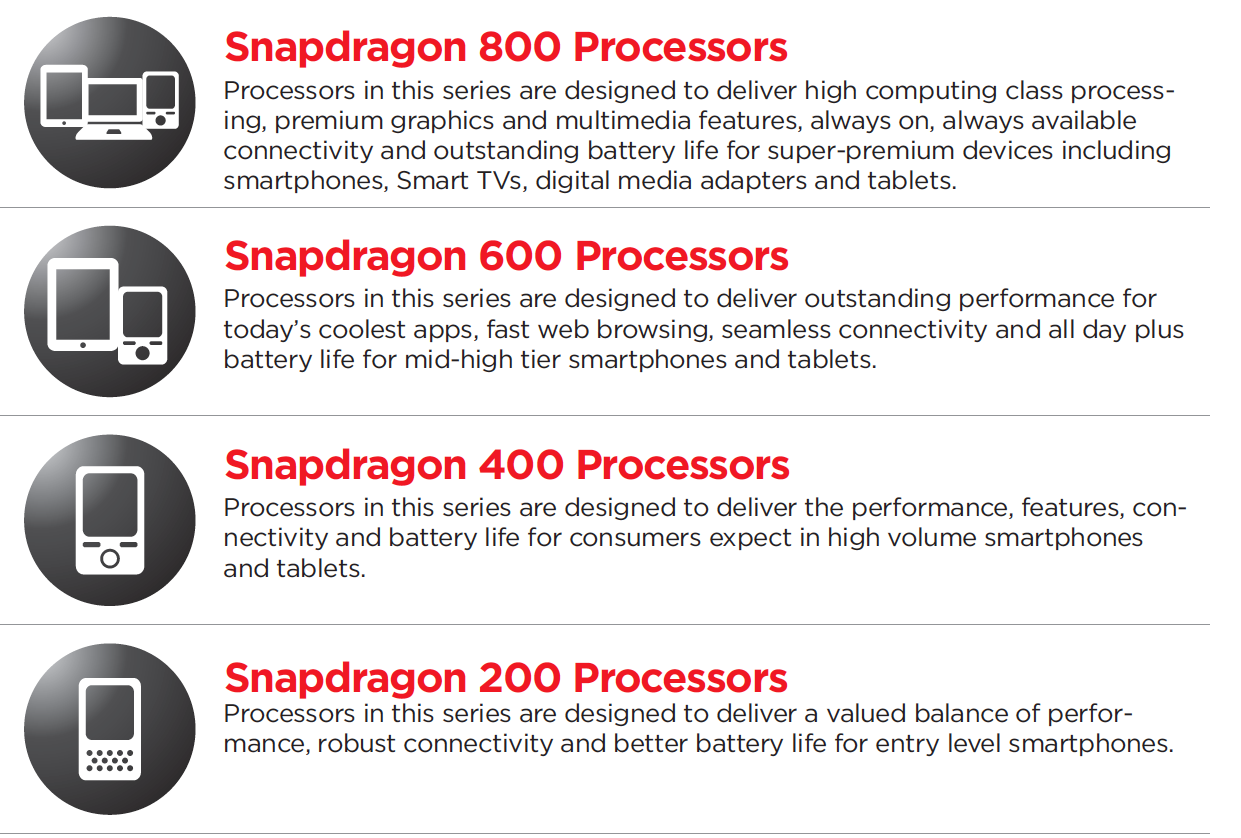Qualcomm Announces New Snapdragon Processors
Qualcomm announced new names and tiers for its Snapdragon SoCs. Currently, performance is segmented into four tiers: S1, S2, S3 and S4. These numbers reflect processor generation and form a loose hierarchy reference similar to Intel's use of Core i3, Core i5. and Core i7.
The 2013 roadmap employs a new naming structure, based on a three digit number. Moving forward, you'll see Snapdragon under the 200, 400, 600, and 800 headings. It's not quite clear how this affects existing Snapdragon products. For example, the company hasn't clarified if the S4 Pro will get rebranded. We do know that the Snapdragon 600 and 800 should deliver even better performance then the S4 Pro that's dominated the competition (read Snapdragon S4 Pro: Krait And Adreno 320, Benchmarked). Qualcomm, though, is a fabless company, and relies on TSMC for final silicon. As a result, it's interesting to point out that these new Snapdragons still leverage TSMC's 28 nm manufacturing node.
| Header Cell - Column 0 | S4 Pro | Snapdragon 600 | Snapdragon 800 |
|---|---|---|---|
| CPU | Krait 200 | Krait 300 | Krait 400 |
| Max Clock | 1.7 GHz | 1.9 GHz | 2.3 GHz |
| GPU | Adreno 320 | Adreno 320 | Adreno 330 |
| Memory | LPDDR2 | LPDDR3 | LPDDR3 |
| UltraHD | N | N | Y |
We don't know much about the Snapdragon 200 or 400, but the higher tiered 600 and 800 processors employ Krait cores with a bit of a twist. The current S4 Pro technically uses a Krait 200 CPU with a max 1.7 GHz clock. In comparison, the Snapdragon 600 features a Krait 300 CPU clocked as high as 1.9 GHz. The Snapdragon 800 looks even more impressive; it's Krait 400 scales up to 2.3 GHz. This is likely the result of a more mature manufacturing process on the part of TSMC, allowing Qualcomm to employ silicon binning.
| At A Glance | Krait 300 | Krait 400 |
|---|---|---|
| Features Compared to Krait 200 | Added Hardware Data PrefetchImproved Branch Prediction Improved Memory ManagementIncreased Out Of Order CapabilityForwarding Between Pipelines Improved FPU PerformanceImproved JavaScript Performance | Redesign of circuits for High-K 28 nmLower Memory LatencyFaster L2 cache(In Addition to Krait 300 features) |
It's not just about turning up the clock speed, though. The Krait 300 and 400 are both still share a common architecture with the preceding Krait 200. It's true that all three are based on the Cortex-A15. However, the Krait is very much a customized Qualcomm design. However, company engineers tell us the silicon blocks at the heart of these chips have been rearranged. That's kind of an interesting statement. Presumably, this would be to optimize performance a bit. We'll know more in the days ahead.
Interestingly, Qualcomm claims "Snapdragon 600 processor to deliver up to 40% better performance than the Snapdragon S4 Pro processor at lower power." That's a tall order, but the Snapdragon 800 perhaps looks to be a potential performance beast. The Adreno 330 GPU inside the company's new flagship promises 2x better compute and 1.5x better graphics performance than the A320. UltraHD support is also a welcome surprise. Provided vendors employ high quality camera components, the Snapdragon 800 is capable of capturing and playing 4K resolution video. That's four times as many pixels as 1080p (1920x1080 vs 4096x2304). Android 4.0 has a native resolution of 720p, and most things just get downscaled. It'll be interesting to see if how fast software catches up with hardware. If all goes well, though, we should expect devices powered by the Snapdragon 600 by April and Snapdragon 800 by June. Nvidia's Tegra 4 seems to be the main competition, and it'll be interesting to see how these devices fare in a head to head once we get them in the lab.
Contact Us for News Tips, Corrections and Feedback
Get Tom's Hardware's best news and in-depth reviews, straight to your inbox.
-
Parsian Oh man, why do I have a funny feeling these are going to be more powerful than the new Tegra 4??? I just hope Tegra 4 is more adopted for the next year. All the android flagships due this coming quarter are all S4 PRO (with Adreno 320). I bet Samsung will have a model of its S4 that would use the Qualcomm chip as has been in the past.Reply
this is what A6/A6X, S4/S4Pro 200 can pull:
http://www.youtube.com/watch?v=nQvzNFf5900 -
xpeh ParsianOh man, why do I have a funny feeling these are going to be more powerful than the new Tegra 4??? I just hope Tegra 4 is more adopted for the next year. All the android flagships due this coming quarter are all S4 PRO (with Adreno 320). I bet Samsung will have a model of its S4 that would use the Qualcomm chip as has been in the past.this is what A6/A6X, S4/S4Pro 200 can pull:http://www.youtube.com/watch?v=nQvzNFf5900Reply
Nah, Nvidia will just bribe android game developers to better optimize the code for the Tegra 4, or make some games Tegra 4 only. -
stevelord Wake me up when current processors are utilized more, instead of just being gimmicks that only serve to drain batteries faster.Reply
-
g00fysmiley xpehNah, Nvidia will just bribe android game developers to better optimize the code for the Tegra 4, or make some games Tegra 4 only.Reply
nvidia the way its meant to be paid (as a developer)
-
renz496 xpehNah, Nvidia will just bribe android game developers to better optimize the code for the Tegra 4, or make some games Tegra 4 only.Reply
that's how nvidia rolls lol. btw does Qualcom have something similar to nvidia Tegra Zone?
